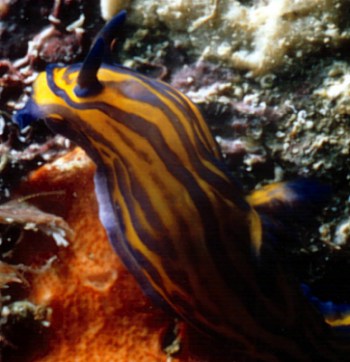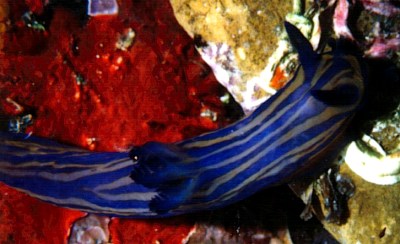

Roboastra europaea
García Gómez, 1985
Order: NUDIBRANCHIA
Suborder: DORIDINA
Family: Polyceridae
Subfamily: Nembrothinae
DISTRIBUTION
Spain.
PHOTO
La Cañonera reef. Bay of Algeciras (Strait of Gibraltar, southern Spain). March 2000.
UPPER: 26 m. depth. Size: 55mm., LOWER: 28 m. depth, Size: 50mm. PHOTOS: Alma Sánchez
The long, limaciform body is lightly corrugated. The rhinophores are perfoliate and retractile and have 35 tightly packed lamellae. There are 5 nonretractile bipinnate gills, the central 3 gills being larger than the other two.
This species is striped with greyish blue and bright yellow longitudinal bands. The entire foot is a pale grey. The oral tentacles are grey. The perfoliated part of the rhinophores are a grey or reddish-grey but the base and tips of the rhinophores are a light grey. The outer face of gills is orange-yellow or blue and the outer edge of the gill leaflets is dark grey or purple. The rhinophore club dark purplish colour. There are two colour forms [See Lucas Cervera's message.]
Compare with Tambja ceutae
Reference:
• Garcia-Gomez, J.C. (1985) A new species of Roboastra (Gastropoda, Nudibranchia) from the Gibraltar Strait (southern Spain). Journal of Molluscan Studies, 51: 169-176.
Rudman, W.B., 2001 (February 11) Roboastra europaea García Gómez, 1985. [In] Sea Slug Forum. Australian Museum, Sydney. Available from http://www.seaslugforum.net/find/roboeuro
Related messages
Roboastra europaea from Portugal
April 25, 2006
From: David Abecasis


Hello again Bill,
Here's another nudibranch of which I'm not sure. Is this a Tambja? If so which species?
Locality: Faro, 16 metres, Portugal, Atlantic Ocean, 13 April 2006. Photographer: David Abecasis.
Many thanks,
David Abecasis
davidbecas@netcabo.pt
Abecasis, D., 2006 (Apr 25) Roboastra europaea from Portugal. [Message in] Sea Slug Forum. Australian Museum, Sydney. Available from http://www.seaslugforum.net/find/16337
Dear David,
This is another nice find. It certainly looks like a Tambja but it belongs to the related genus Roboastra, whose species are hunters feeding on other polycerids, especially species of Tambja. Your species is appropriately named Roboastra europaea.
Species of Tambja can be identified by the large enrolled oral tentacles you can see on each side of the mouth. Species of the bryozoan feeding genus Tambja, and the ascidian feeding Nembrotha, don't usually have such enlarged tentacles, although there are some exceptions such as the recently described Tambja tentaculata.
Best wishes,
Bill Rudman
Re: Roboastra europaea from Senegal
May 7, 2003
From: Juan Lucas Cervera
Dear Bill,
This is the southernmost record of Roboastra europaea in the Atlantic.
Regards.
Lucas.
lucas.cervera@uca.es
Cervera, J.L., 2003 (May 7) Re: Roboastra europaea from Senegal. [Message in] Sea Slug Forum. Australian Museum, Sydney. Available from http://www.seaslugforum.net/find/9875Thanks Lucas,
Bill Rudman
Roboastra europaea from Senegal
May 3, 2003
From: Marina & Patrice

Dear Bill,
Here is another guy from Dakar, Senegal. Could you confirm it is Roboastra europaea, please?
This photo was taken by Patrice in April 1999 near Goree Island, at a depth of 10m.
Best wishes,
Marina Poddubetskaia
nembro@nembro.info
Patrice Petit de Voize
PdeVoize@aol.com
Poddubetskaia, M. & Petit de Voize, P., 2003 (May 3) Roboastra europaea from Senegal. [Message in] Sea Slug Forum. Australian Museum, Sydney. Available from http://www.seaslugforum.net/find/9652Dear Marina & Patrice,
Another interesting find. I agree with your identification, but don't know if there are any west African records of this species. It is possibly another new record.
Best wishes
Bill Rudman
Roboastra europaea from Spain
February 8, 2001
From: Alma Sánchez


Dear Dr. Rudman,
Here are two photos of Roboastra europaea García Gómez, 1985. This specimen was collected in March 2000 at the Bay of Algeciras (Strait of Gibraltar, southern Spain) at 26 m. depth. Size: 55mm., Place: La Cañonera reef.
By the way, I am sending some photos of a colour variation of this species in a separate message.
Best wishes,
Alma Sánchez
almasanchez83@hotmail.com
Sánchez, A., 2001 (Feb 8) Roboastra europaea from Spain. [Message in] Sea Slug Forum. Australian Museum, Sydney. Available from http://www.seaslugforum.net/find/3729Dear Alma,
Thanks very much for these photos of this interesting species, the first known Roboastra in the Atlantic.
Bill Rudman
Tambja ceutae from Spain
February 8, 2001
From: Alma Sánchez


Dear Dr. Rudman,
Here are some photos of Roboastra cf. europaea García Gómez, 1985. Specimen collected in March 2000 at the Bay of Algeciras (Strait of Gibraltar, southern Spain) at 28 m.depth, Size: 50mm, Place: La Cañonera reef.
Cheers,
Alma Sánchez.
almasanchez83@hotmail.com
Sánchez, S., 2001 (Feb 8) Tambja ceutae from Spain. [Message in] Sea Slug Forum. Australian Museum, Sydney. Available from http://www.seaslugforum.net/find/3730Dear Alma,
I am pretty sure this isn't a colour variety of Roboastra europaea. I think it is Tambja ceutae, which was first found at Ceuta, Straits of Gibraltar. It is similar in external appearance to R. europaea but lacks the large oral tentacles of that species and has a bright blue outer face to the gills rather than bright yellow. In this species the yellow lines are much thinner than in R. europaea. I don't know how big it grows. The original specimen was about 35mm long.
Although these two species look very similar, species of Roboastra are hunting carnivores, eating other opisthobranchs, while species of Tambja graze on bryozoans.
Best wishes,
Bill Rudman.
Note added Feb 11 2001: See Lucas Cervera's message showing this is a colour form of Roboastra europaea.
Rudman, W.B., 2001 (Feb 8). Comment on Tambja ceutae from Spain by Alma Sánchez. [Message in] Sea Slug Forum. Australian Museum, Sydney. Available from http://www.seaslugforum.net/find/3730Re: Spelling of Roboastra
May 2, 1999
From: Juan Lucas Cervera
Hi Bill!
Thanks for your reply. I really have not detected your mistake spelling Roboastra.
I have no photographs about the feeding of Roboastra europaea, but a video movie of some laboratory experiences in which it can be seen several attacks on some nudibranchs. It also can be seen that it doesn't attack other nudibranch species that were offered. The scenes of the attacks are really impressive! Most of the victims cannot escape from the Roboastra at the first (and single) attack.
A question very interesting to study is if one species of Roboastra with a wide geographical range has always a preference to some preys or these can change depending of the geographical area.
Regards.
J. Lucas Cervera.
lucas.cervera@uca.es
Cervera, J.L., 1999 (May 2) Re: Spelling of Roboastra. [Message in] Sea Slug Forum. Australian Museum, Sydney. Available from http://www.seaslugforum.net/find/823Feeding habits of Roboastra
April 30, 1999
From: Juan Lucas Cervera
Hi Bill!
I have readed the different messages and replays about the subject 'Tambja affinis v. Roboastra luteolineata' recently. I'm absolutely in agreement with you respect to the identification of nudibranchs in many of beautiful books of photographers. Some people send me slides of opisthobranchs for their identification, and many times I reply that I would need the specimen/s to examine the internal anatomy.
I'm very interested to receive all the known information about the feeding of Roboastra, that is poor except for Roboastra tigris. I am finishing a paper about the feeding habits of the European species Roboastra europaea. I have examined the digestive contents of more than 30 specimens, moreover to have carried out field and laboratory experiences in which specimens of Roboastra europaea meet different species of the same or different families of nudibranchs.
I think it would be very interesting to compare our results with those of other species of Roboastra.
Regards.
Juan Lucas Cervera.
lucas.cervera@uca.es
Cervera, J.L., 1999 (Apr 30) Feeding habits of Roboastra. [Message in] Sea Slug Forum. Australian Museum, Sydney. Available from http://www.seaslugforum.net/find/820Dear Lucas,
I'm afraid I have no feeding records of Roboastra in Australia and New Zealand. I hope some of our New Zealand friends have made a mental note to look for and photograph them in the act! One of my aims with the Forum is to provide a place where people can report such finds and publish photos for everyone's benefit.
Your work on Roboastra europaea sounds fascinating. Any chance of a photo for the Forum? I planned to restrict the Forum to Australia and New Zealand, but it didn't take long to realize its definitely World Wide, so I am happy to receive photos of any of your interesting and equally beautiful animals.
Best wishes,
Bill Rudman.
Spelling of Roboastra
April 30, 1999
From: Bill Rudman
On reading through Jean Lucas Cervera's message I suddenly noticed that I have been spelling Roboastra without the second 'o'. Sorry about that. I have corrected the spelling in all past messages. I can only presume nobody has corrected me out of politeness, I would hate to think that nobody had noticed.
Bill Rudman.
